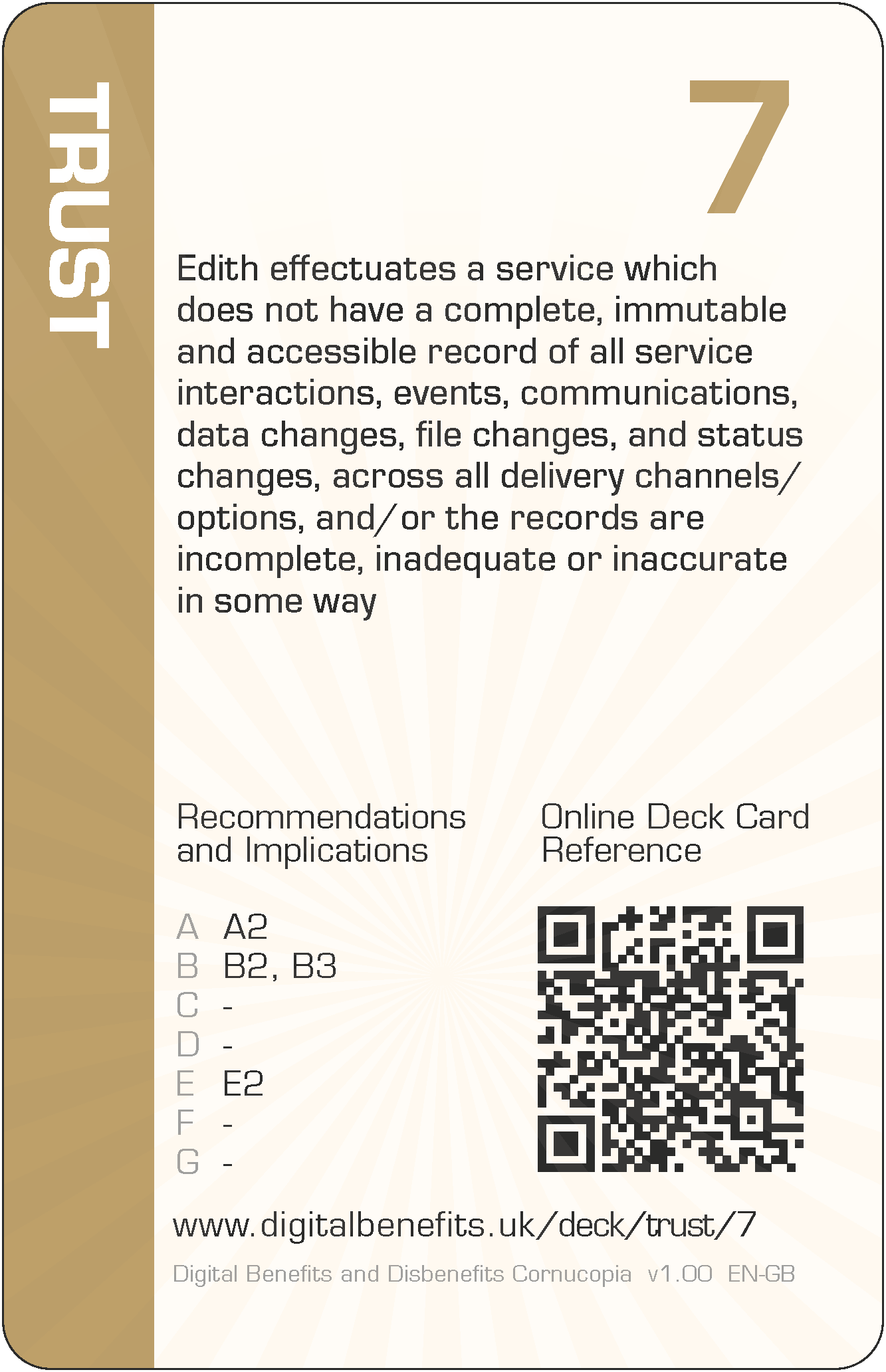Trust 7 (TR-7) Card
DBD Cornucopia > Deck > Trust > 7
Card Details - Seven of Trust
Abbreviation
TR-7
Card's focus
The focus of this card is records
Threat to claimants
Edith effectuates a service which does not have a complete, immutable and accessible record of all service interactions, events, communications, data changes, file changes, and status changes, across all delivery channels/options, and/or the records are incomplete, inadequate or inaccurate in some way

Threat to claimants
Edith effectuates a service which does not have a complete, immutable and accessible record of all service interactions, events, communications, data changes, file changes, and status changes, across all delivery channels/options, and/or the records are incomplete, inadequate or inaccurate in some way.
Some examples of how this threat could lead to harms (negative effects on claimants)
The design recommendations and implications relevant to the card are listed below in the next section, but even those can be somewhat abstract and difficult to think about during practical day-to-day implementation. Therefore, some example harms are provided to complement the more formal research outputs. These examples are unique per card, and are only published on these web pages (i.e. in no other project outputs).
- Claimants are unable to contest sanctions because the action they have incorrectly been blamed about was not recorded correctly in the system, leading to financial loss for claimants
- Claimants cannot obtain an accurate record of all their service interactions, data used and decisions, for use in an appeal and thus limiting what they can provide as facts
The examples are to help understand the threat on the card, not to suppress thinking and innovation. Incorporating these examples exactly, or closely matching ones, should be scored down when playing DBD Cornucopia as a game.
Applicable design recommendations and implications
These are reproduced here from Research Briefing N
Support claimants’ own ecosystems
- Generate structured data for visibility and re-use by claimants and other actors
Provide, signpost and explain functionalities to span the fullest range of claimant activities, so as to reduce the need for and use of messaging/chat interactions (like the UC Journal) which result in unstructured data. Ensure the structured data enables re-use to increase wider ecosystem efficiencies: provide for recording and keeping full records of every interaction by every channel (including files, form submissions, all communications), and provide methods to ensure information can be found and referred to, and easily exported or shared with others as required.
Acknowledge claimants as people in digital design
- Ensure system and state accountability to claimants
Equalise accountability between claimants and the state. Promote a sense of fairness by enforcing an expectation that service level standards for actions and response times should be similar to those expected of claimants, with related penalties not disproportionately, or only, affecting claimants. Provide tools/methods for claimants to easily check, query and challenge actions and decisions. - Provide clear and configurable communications about process and decision statuses
Use methods proactively, such as internal notifications and external alerts, to help people understand what they need to do/when, and what is in progress by others. Provide confirmations when actions have been completed, information received, decisions made and statuses changed. To accommodate people's individual needs and preferences, provide choices about what, when and how these are re- ceived, who they are sent to and copied to. Offer content options such as whether to have a topic, priority and hyperlink, and ensure it is clear where and how to complete any required action.
Design systems which support the division of labour with claimants' ecosystems
- Expand claimant autonomy, control and choice, backed up by transparency of actions and activities
Enable claimants to better engage with digital welfare and empower them to make their own choices and decisions. Attribute information sources, other advice and decisions; build in logging and audit trail generation; provide access to records of what information was used to make choices/decisions and by whom; provide mechanisms for claimants to question, discuss and challenge actions, provide feedback, and make complaints.
General Notes
Card values (i.e. '7' for this card) are for game play and are not correlated with the severity of harm. This is because threats cannot be ranked directly since they can affect individuals in different ways due to situations and circumstances, or affect fewer or more claimants, or the harms can arise in claimants' support networks and wider society.
The threat description uses a person's name as the "attacker" (i.e. 'Edith' for this card), which can be thought of someone involved with implementation. They could have any role which influence digitisation. So they could be a database administrator, or a copy writer, or a quality assurance specialist, etc, or all of these. Everyone could have some influence on the claimant threat described. The names were randomly selected from those currently most popular as given names for boys and girls (UK Office for National Statistics).
The example harms provided are drawn from the research data (which explored not only parts of existing services but also the effects of possible changes to those), from the author's own knowledge of web application development and testing, the author's own experience of helping citizens to claim Universal Credit (UC) and Personal Independence Payment (PIP), and from suggestions submitted by other people (make a suggestion). The threats and example harms do not necessarily exist in the current UC or PIP deployments or in ecosystems around those services, but they might well do.
All the cards in this Trust suit are: 2 3 4 5 6 7 8 9 10 J Q K A
The other suits in the deck are: Scope, Architecture, Agency, Porosity and Cornucopia (plus Jokers).
